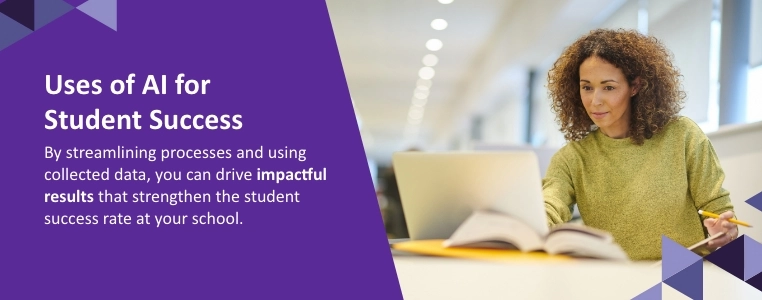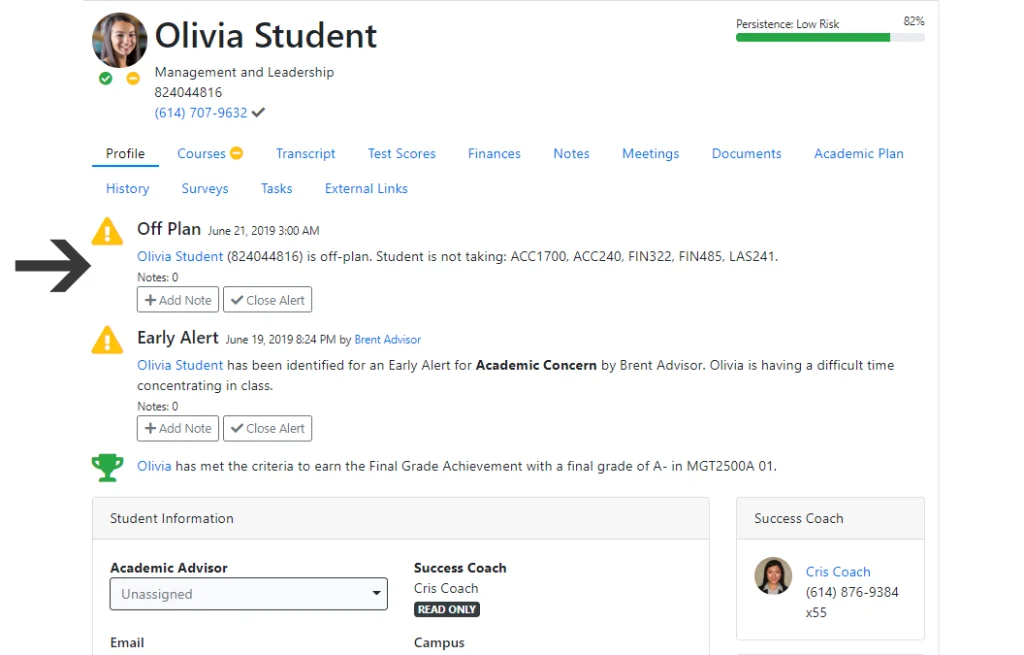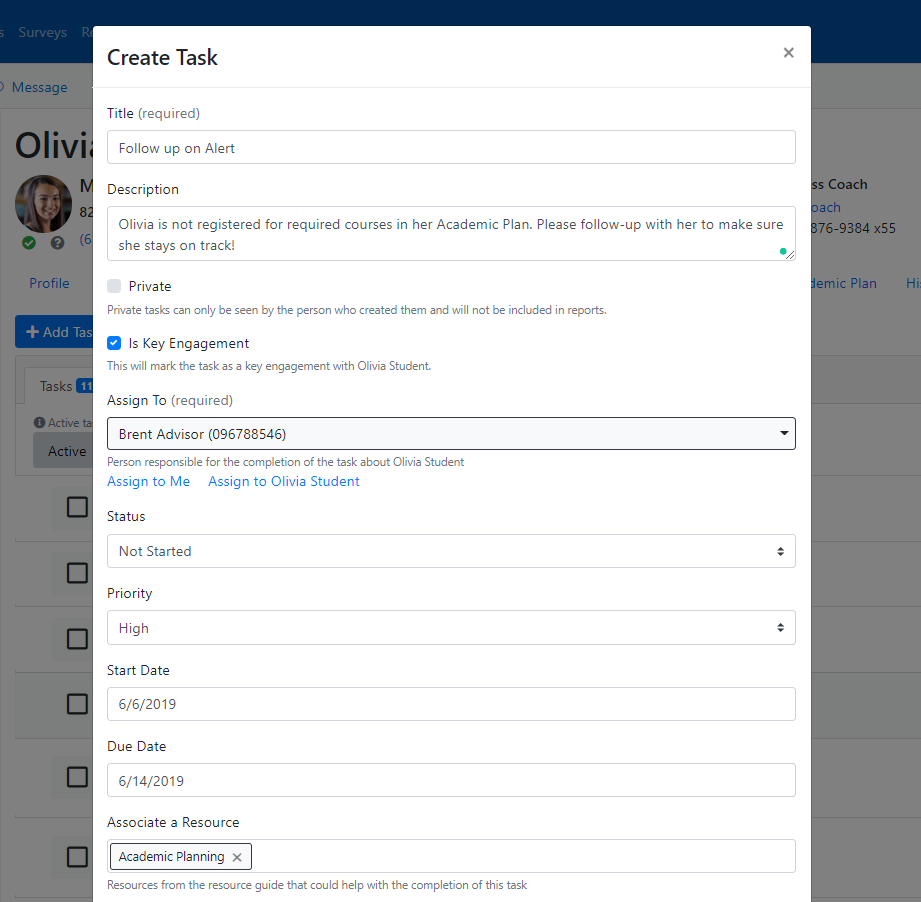
There are numerous reasons why a college student may fail a class or drop out of school altogether. For example, they may lack time management skills, feel unable to comprehend the material or keep up with the coursework, face problems at home, or have health issues. Many students also face financial obstacles to completing on time, regardless of their academic achievement.
Artificial intelligence (AI) can help perform many tasks across industries. Understanding how it applies to education can identify more ways your school can support student success for better results and learning outcomes.

Uses of AI for Student Success
Higher education institutions can implement AI to accomplish many goals unique to your industry. By streamlining processes and using collected data, you can drive impactful results that strengthen the student success rate at your school. Here are some ways AI can support student success:
Identify Obstacles to Student Success
The numerous obstacles that prevent student success can make it overwhelming for faculty and advisors to know who might be struggling and when to intervene. As faculty and advisors find themselves with students who are more likely to be low-income and who face more obstacles than previous generations, they may not have enough time to identify and address these issues.
Luckily, with the advent of new data analytics and predictive modeling techniques, higher education institutions have a new tool to help them support student success — artificial intelligence. Before you conjure up images of robots and massive computers, consider this real-life scenario of how a higher education institution used AI to ensure student success:
“The predictive analytics and risk factors allow me to be more proactive in my outreach to students. They guide my interventions and connections to resources and strategies,” said Pamela Wiggins, Success Coach at Randolph Community College.
“One particular student that comes to mind is one who, through Watermark Student Success & Engagement software, I saw had a pattern of online course withdrawals and a direct correlation between attendance and his academic performance. We developed an academic plan that, initially, included only seated classes, and then gradually included online courses once his confidence and skill set in online proficiency was acquired. In addition, during semester registrations, we worked on choosing course sections that were offered at times that were conducive to his attendance — which for him was avoiding early mornings.”
At Watermark, we see this example as a sign of how both AI and human intelligence (the knowledge, skills, and abilities of the faculty and advisors who serve students) can come together to provide a more efficient and effective student success program at your institution.
“We know through our experience supporting technology-enabled success coaching, that when you combine strong, consistent student relationships with the right information, delivered at the right time, staff can intervene proactively and quickly to solve issues before they become attrition-risk problems,” said Heather Taynor, Vice President of Client Success at Watermark.
College faculty and advisors have years of training and experience that make them the front line of addressing student needs. With regular student interactions, they often are the first to know when a student is struggling —sometimes even before the student notices. Higher education professionals build relationships and trust with students and can adjust their approach to learning when they find out that a student’s parent is ill or that the student is struggling with anxiety. This information informs conversations faculty and advisors have with students and shows them how to take action.
However, we don’t always know from talking with a student whether they have an issue that will impact their academics. Many students fall through the cracks, especially first-year or transfer students and those who do not ask for help. Often, an otherwise successful student experiences a hardship that impacts their attendance in class, with a snowball effect that is quick and otherwise unnoticeable in the absence of centralized attendance tracking.
This is where the insights gathered from Watermark Student Success & Engagement can come in. The academic information gathered through Watermark Student Success & Engagement over a student’s academic career paints a picture of how a student will progress in a particular class and across their academic tenure.
For instance, Watermark can utilize information on attempted credits, GPA, prior college experience, absences in course meetings, and previous class completions or withdrawals to predict whether a student is at risk of not completing a particular class and whether they are at risk of dropping out altogether. In fact, Watermark is able to predict with as much as 88% certainty whether a student will fail a class without support or intervention from faculty and advisors.
Thus, the additional layer of data received through the predictive risk indicators can help advisors balance this granular data with the personal information they already know about the students to develop an individualized success plan.
Streamline Processes for Higher Education Professionals
Professors and staff work with students daily. Their actions can improve the student experience and strengthen their performance, improve their relationship with the school and community, and connect them with essential resources.
However, many faculty members have countless responsibilities and tasks to manage, limiting the time they can spend with students. Professors alone are responsible for grading, creating lesson plans, determining readings, and communicating with students while managing their research and publication responsibilities. Faculty members also have more department-specific duties to complete while serving student needs.
You can improve the student experience and interactions with your staff by implementing AI across departments and functions. AI that handles menial, manual tasks can save time for individuals, allowing them to spend more attention on other tasks. AI can handle checking for plagiarism, creating lesson plans, and inputting grades.
While they have more time to dedicate to working directly with students, professors and faculty members can also use the time to decompress and approach other items on their to-do lists, leaving them more prepared for lessons, lectures, events, and student meetings. Interactions with students become more meaningful and impactful, allowing them to better assist students and provide them with knowledge and services that support their academic success.
Increase Communication Efforts
Communication with students can drive their success by ensuring they get answers to their questions and receive relevant information about their academic journey. AI can streamline communication with students through automated messages and chats.
With automated messaging, students can receive reminders about upcoming deadlines, from individual assignments to class registration and tuition payments. AI can record and remember student preferences to send out text and email campaigns, so communication efforts are more effective and tailored to student needs. With frequent reminders, students can remember essential steps they need to do well, supporting their academic path and success.
Your AI tools can also analyze student performance and activities to determine their risk level. Students with low grades have higher risks of failing classes and losing financial aid, which can impact their enrollment and graduation status. AI can reach out to these students, sending information about tutoring, office hours, mental health services, and academic success centers. By increasing awareness about available resources on campus, students can better support their needs.
AI chats have increased in popularity across industries because they provide constant support for users visiting online sites and resources. With chats, students can ask questions about school services. They might have questions about how to register for classes or how to see their remaining graduation requirements. Instead of waiting for a faculty member to respond to an email, AI chats offer immediate results, so students can get help whenever they need it.
Prioritize and Inform
How can we combine human intelligence with the predictive modeling and early-alert system of Watermark Student Success & Engagement? To do so is to combine the power of human intelligence with learner analytics to improve our ability to predict which students will be in trouble and offer outreach to them before the problem becomes too difficult to handle.
While artificial intelligence cannot replace human intelligence, it can help those in support roles determine who is at risk of dropping out or failing a class. In other words, this technology can allow you to prioritize which students to support — and when — through the information gathered to determine risk.


After a student has been identified as being at high or medium risk for failing a class or dropping out, faculty and advisors still need to do the work of reaching out to those students and designing a game plan to help them persist. Watermark Student Success & Engagement software helps advisors be more efficient with their time, identifying students who need support but who may not ask for it, while still being able to respond to the everyday issues that arise when educating vulnerable populations.
Support Student Success With Watermark
As a higher education professional, you use data every day — in your research, each time you interact with a student, and when your institution engages in day-to-day business. Now, the power of AI has opened higher education’s ability to really reach students. This information can be overwhelming, but luckily Watermark Student Success & Engagement makes it easy to determine which students are at risk of failing a class or dropping out — and to reach out to those students most in need.
We at Watermark, with our personalized and dedicated customer service team, can help you craft an early-alert system that works best for your institution’s needs, increasing student retention and completion. We can also work with the stakeholders at your institution to train and support them in their use of this powerful system.
We still need people to do the work of reaching out to students, determining interventions, and creating referrals. But now, there is a powerful tool at your fingertips that takes the guesswork out of knowing who to support and when. Watermark Student Success & Engagement software helps faculty and advisors do what they do best, but with more precise information.
The goal is to have better conversations, referrals, and interventions. When combined with the notes and alerts in Watermark, as well as what staff already know about the student, Watermark Student Success & Engagement can take some of the guesswork out of knowing when and why to intervene, going as far as telling you how to intervene.
Faculty and advisor time is valuable. Make the most of it by enabling more targeted mentoring. Request a demo today and discover how Watermark solutions can support student needs at your higher education institution.

















































































































































































































































































































































































































